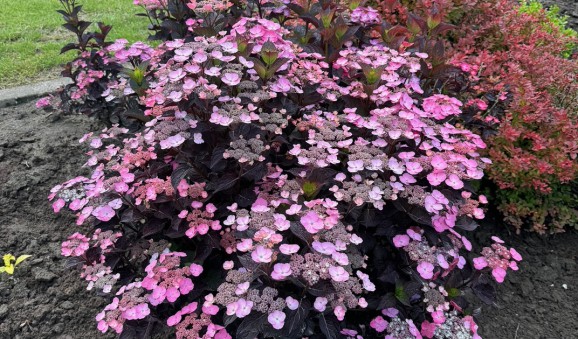- HOME >
- NIEUWS >
- Cultivation 14-07-2024
Colours in the tree nursery: why certain colours do not exist in plants
Anyone who takes a look at an average tree nursery can’t miss the overwhelming presence of green. Green is the signature colour of the nursery stock industry. It’s no coincidence that the largest industry-specific trade fair is called GrootGROENPlus (‘Groen’ being Dutch for GREEN). But why is that? Why is green the predominant colour found in nature? Why can’t we brighten up our gardens with a beautiful blue Ginkgo? And what possibilities do we have for creating beautiful, colourful plants? We delved into these questions.
How do plants get their colour?
In the chloroplasts of plants, the substance chlorophyll can be found. This pigment is primarily responsible for absorbing light energy and converting it into nutrients through photosynthesis, which is the process by which sunlight stimulates plant growth. Chlorophyll absorbs blue and red light from the sun but hardly any green light. This ‘leftover’ green light is what gives plants their predominantly green appearance. Of course, chlorophyll is not the only pigment in plants. We also know of xanthophylls and flavonoids. Xanthophylls are yellow pigments found in plants that help absorb light energy. They also play a role in protecting plant cells from harmful UV radiation. Flavonoids are a group of pigments responsible for the colours of flowers and fruits. They help attract pollinators and protect plant cells from UV damage, which can result in a variety of colours. You might have even come across silver-coloured plants. These are not actually coloured by silver pigment; their silvery sheen is caused by fine hairs that reflect light. This is often seen in shade plants that don’t receive direct light. If they do unexpectedly get direct light, the silver hairs help reflect it to other plants, preventing the leaves from burning.
Adjusting to the surroundings
While having a specific colour may not seem crucial for plants, absorbing light certainly is. And this is closely related to a plant’s colour. But let’s take a step back: factors that influence light absorption in plants include light intensity and quality, the presence of other pigments, and the plant’s overall health. Plants have developed various colours to adapt to their environment and to communicate with other organisms. For instance, flowers have evolved bright colours to attract pollinators, while leaves have adopted a green hue as an efficient way to absorb sunlight for photosynthesis. Environmental factors such as light intensity, temperature, humidity, and soil composition can all affect a plant’s colour. Plants exposed to high light intensity may develop a darker green colour to protect themselves from excessive light energy. Conversely, plants exposed to cold temperatures might turn purple as a stress response. Additionally, other environmental factors like soil composition and nutrient levels can also influence the colour of plants.
A garden with a personality, thanks to the Colour Circle
But how do you creatively work with different colours in a garden? How do you bring it to life and add personality without overlooking the practical functions of various colours? The Flower Garden of Appeltern (Bloementuin van Appeltern) provides an excellent example with its Colour Circle. This circle comprises twelve colours: six warm colours and six cool colours. Warm colours range from red and gold to orange and evoke warm elements like the sun or fire. Cool colours, such as blue, green, and magenta, are the shades of winter and night, reminding us of cool things like water or grass. The principle of the colour circle is based on the three primary colours: red, blue, and yellow. When these colours are mixed, they form the secondary colours: orange, purple, and green. Beyond the primary and secondary colours in the circle, there are also tertiary colours. These arise from mixing a primary colour with a secondary colour. Examples include yellow-orange, red-violet, and yellow-green.
Within the plant world, there is a unique colour system. All effects depend on the surrounding colours and light. Flowers with warm colours give a different effect than those with cool colours. In the garden, green foliage helps to connect all the plants, creating a cohesive environment. The other colours from the colour circle add individual character to the garden. Soft pastel colours provide a serene look, while bright colours make your garden lively and dynamic.
Autumn colours
Each season can introduce different colour variations in the garden, especially during autumn. In autumn, the leaves of trees and shrubs change colour, often resulting in a spectacular burst of hues. As mentioned earlier, chlorophyll, one of the primary substances, is crucial in summer for photosynthesis, producing sugars and starch using sunlight and carbon dioxide. During high temperatures, this green pigment is continually produced. However, as temperatures drop in autumn, the production of chlorophyll ceases. The green pigment in the leaves diminishes, allowing other pigments, previously hidden, to become more prominent. Before the leaves eventually fall off the trees, the remaining chlorophyll is withdrawn from the leaves and stored in the branches. This makes the remaining pigments visible, creating a beautiful autumn palette. Carotene gives the leaves their orange colour, xanthophyll imparts yellow, anthocyanin provides red, and tannins give a brown tint.
No black flowers
Yet, we don’t see all colours in the garden. If you look closely, you’ll see that black is always missing. Despite the efforts of breeders, there’s no actual black pigment to work with. While there are some flowers referred to as ‘black’, they aren’t genuinely black. They lack true black pigment and are usually very dark shades of purple, brown, or even red. And perhaps, up to now, there hasn’t been a real need for it. The colours that naturally occur often create their own ‘special effect’. For instance, weather presenter Helga van Leur once pointed out the Euonymus, commonly known as the spindle tree. When its purplish-pink seed capsules split open, the bright yellow berries inside stand out strikingly. So strikingly, in fact, that Vincent van Gogh used a similar technique in his painting ‘Café Terrace at Night’, where he painted the stars in the sky purple to make the yellow of the café terrace appear even warmer and more vibrant. Just as the yellow berries become more attractive to birds against the purple background, art lovers tend to linger a bit longer in front of this painting. The colours in nature - including green - exist for a reason.
What do our particpants think?
Jelle Havermans of About Plants has a strong opinion on this: “Only genuinely new innovations are truly interesting. A small adjustment in colour or shape can certainly be an improvement, but in such cases, it’s essential to retire the old variety from the market. A true innovation, one that significantly differs from existing types in terms of colour, leaf shape, growth habit, or resistance, often performs well in the market initially. However, it’s crucial to observe how the plant actually fares over the following years in gardens, on balconies, or in public green spaces,” says Jelle. “It’s about making choices,” Jelle continues. “Making the right choices as a grower or trader is vital, but not always easy given the vast diversity within any given range. As a grower, you can’t produce everything. I would advise: choose a particular direction and stick to it. Moreover, there’s an even more important consideration today; can the innovation be cultivated responsibly, or ideally, without the use of pesticides?”
Minier Professional Solutions, from Beaufort and Anjou (F) was founded in 1838, in the Anjou, which is also known as ‘the garden of France’. Minier has expanded its cultivated area to over 300 hectares, which includes an exceptional plant collection that is invaluable for creating new varieties. The mild climate, the warm summers, and the fertile silt from the river Loire provide ideal conditions for producing hardy and frost-resistant plants. Minier offers a vast selection of trees, fruit trees, shrubs, conifers, climbers, bamboos, and grasses. Their specialities include Hibiscus, Hydrangea, Magnolia, Syringa, and Wisteria. Each year, 4 million shaped plants and 10 million young plants are shipped across Europe, as well as to the United States, South Africa, and Japan.
The importance of selection
“Since humans settled and agriculture began, production has improved through the selection of species and clones,” says Olivier Pallussière. “We have seen the same phenomenon for centuries in horticulture. Everyone values the innovation level of a plant according to their own criteria: a grower is attracted by vegetative qualities or disease resistance, while the end customer is primarily drawn to attractive shape or colour. Therefore, it is important to establish a research focus when conducting hybridisation and selection work. These objectives can vary depending on the plants we are working with: flower colour and size, plant shape, flowering in the first year of cultivation, pot production, etc. Throughout the selection process, these numerous criteria can be taken into account to define a new plant, and they should be compared with existing varieties to maintain a critical perspective. It is important to continually add new varieties to our range to enhance the quality and aesthetics of our plants and thus stimulate the market. “And,” Olivier Pallussière adds, “let’s not forget that customers’ first question is always the same: ‘What’s new?’”
Van Vliet New Plants from Stroe, is specialised in the introduction, exploitation, and management of new plant species protected by plant breeders’ rights. When a grower is sufficiently convinced of the potential of their new variety, they have the option to bring it to market through a specialised company like Van Vliet New Plants. After concluding a trial agreement, a number of plants are distributed to specialised growers within the network. Over a specified period (usually 2 years), these growers test the plant for its qualities to provide a thorough assessment. If the plant performs well during the trial period, they can apply for plant breeders’ rights. This can be done on a country-by-country basis, per continent (such as Europe), or globally. It must be demonstrated that the plant meets all requirements regarding novelty, distinctiveness, uniformity, and stability. Once a new cultivar is launched, it is crucial to continuously manage and promote it. “There’s no point flooding the market with novelties,” says Sander van Vliet. “It should be about innovations that genuinely contribute to the assortment. Many minor mutations are often chance discoveries, and careful consideration is needed to determine if the market is interested in that mutation. Because even with novelties, it’s about responding to market interest. A completely new colour is certainly interesting, but factors like disease resistance, low maintenance, and compact growth habits are also important considerations.”
On behalf of Vakbeurs GrootGroenPlus: Erik Bastiaensen, member of the board
“The nursery stock industry clearly shows that there’s no such thing as one type of green! But what colours do we see and why? Some of the participants of the trade fair also shine a light on this and show us their true colours...”


